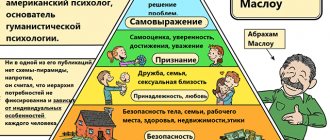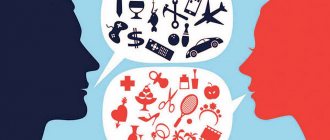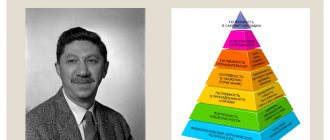Social, spiritual and material needs
The needs are so diverse that there are many classifications of them. In classical science, it is customary to distinguish 3 groups of needs: social, spiritual and material. The first place is given to material satisfaction: in clothing, housing, water, food. The means by which needs are satisfied are called material goods. These can be essential or luxury items, as well as services (consultations with a lawyer, doctor, car repair, etc.).
Spiritual needs are associated with the need for the development of the individual as a personality. They are satisfied by obtaining an education, reading books, engaging in art, and possessing information.
Through the participation of people in public and collective activities, socio-economic needs are realized: in trade unions, parties, public foundations, creative circles, and charitable organizations.
Fromm and McClelland's classifications of social needs
German sociologist Erich Fromm classifies social needs differently. He divides them into:
- connections (a person’s desire to become part of a team or group);
- affection (showing friendship and love, willingness to exchange warmth of feelings);
- self-affirmation (emphasis on the intention to show and establish one’s importance in the eyes of others);
- self-awareness (the desire to indicate one’s individuality, to stand out from the crowd);
- guidelines (criterion of behavior based on traditions, culture and religious ideas with which a person correlates his actions).
American psychologist David McClelland divides social motives and personal needs differently, based on the characteristics of a person’s character. He identifies 3 factors:
- Power. People strive to have power and monitor the actions of others. Moreover, some go to power for its own sake, while others set as their goal the settlement of the needs of others.
- Success. This need is realized under the condition of a favorable completion of the undertaking, when a person is required to show initiative associated with risk. If the project fails, the individual will not repeat it, remembering the failure.
- Involvement. Wanting to become part of a team and jointly implement a project, people gain the trust of others and maintain a conflict-free existence during its implementation.
Other classifications of needs
There are other divisions. For example, according to the types of subjects of needs, they are divided into public, collective, family and individual. Representatives of neoclassical science in economics (for example, A. Marshall, an English economist) divided them into relative and absolute, lower and higher, urgent and those that can be postponed, indirect and direct. Needs are also identified by sphere of action: communication, labor, recreation (restoration of working capacity, rest) and economic needs. Let's take a closer look at the last type.
Economic needs are part of human needs, for the satisfaction of which there must be production, exchange, distribution and consumption of services and goods. It is this type of need that is involved in the interaction between unsatisfied demands and production.
Classification and areas of activity
There are several dozen bases for classifying social groups: by gender, age, time of founding, goals, forms of leadership and organization, place of residence, nationality, religion, financial status, etc.
In terms of numerical composition, groups can be small (from 2-3 people to several dozen members) and large.
Socially useful work is inherent in so-called prosocial groups. Their ideas, forms of organization, goals, methods of activity do not contradict social tasks and norms of life, but, on the contrary, bring a positive element. Members of such a group support government programs, for example, nature conservation, and partially solve them at the local level.
The needs satisfied in antisocial groups are based on antisocial values and interests: alcoholics or drug addicts get together to drink alcohol and drugs. Sometimes they help each other in obtaining funds for their purchase and provide mutual support within the framework of their morality. Family and social values are relegated to the background.
Antisocial groups and factions are aggressive, their goals and activities are demonstratively radical. They can be political (fascist organizations), criminal, declaring outwardly pro-social goals. However, their actions fall under the articles of the Criminal Code, since they are organized and prepared crimes.
Maslow's theory
The theory of A. Maslow, an American sociologist (his photo is presented below), has gained great popularity in modern Western literature. All needs, in accordance with this classification, can be arranged in the form of a pyramid, in ascending order from material (“lower”) needs to spiritual (“highest”) needs.
The following types are distinguished:
- physiological needs (drinking, eating, etc.);
- safe (protected from fear, anger and pain, etc.);
- in social connections (friendships, family, religious);
- in acquiring social status (approval, recognition);
- in self-expression (realization of personality abilities).
This classification can be presented in the form of a pyramid, at the top of which there will be needs for self-expression, and at the base - physiological. Lower order needs, according to Maslow, are physiological and safety needs, and higher order needs are for social status and self-expression. Higher needs do not arise until the lower ones are satisfied.
Types of needs
There are two main groups of needs.
Man is one of the representatives of mammals, therefore physiological needs (natural) are the same for all people and animals: food, water, air, warmth, sleep, sex. Without satisfying these primary needs, the continuation of the life of the individual and humanity in general is impossible.
The diversity of the group of secondary needs is explained by the diversity of human interests:
- in material prosperity;
- in comfort;
- in social recognition, communication, love and friendship;
- in satisfying cognitive and spiritual interests.
Failure to satisfy these needs does not lead to the death of a person, but creates psychological or physical discomfort. This creates specific goals and motives for certain actions that lead to the satisfaction of needs.
Interrelation and interdependence of needs
You can supplement the classification of needs by highlighting the following types: irrational and rational, concrete and abstract, unconscious and conscious, etc. But it should be remembered that any classification is quite conditional, since economic needs of one type or another are interdependent and interconnected. The material needs of people appear not only under the influence of the vital functions of the human body, but also to a significant extent under the influence of scientific, technical and economic development of society, social and spiritual guidelines. And the social, intellectual and spiritual needs specific to any social stratum and individual person arise under the influence of material ones. They largely depend on the degree of satisfaction of the latter.
What are needs
A need is an acute lack of something. It activates a person’s mental and physiological forces to search for ways and means to satisfy it.
The groups of needs are few in number, but they stimulate human life activity. For example, the need for food pushes one to find or earn money to purchase it: searching for paid work, begging, theft, deception, bank loan. The choice of ways to satisfy needs depends on the level of moral and physical development, and on the circumstances of a person’s life.
Historical nature and dynamism of needs
The economic needs of society are historical in nature. The methods of satisfying them and their extent depend on the life demands and habits with which society as a whole, social strata and individual people were formed, that is, in what socio-historical conditions they find themselves. The economic needs of society are dynamic. Social progress, human improvement, intensity of information exchange - these are the factors under the influence of which requests change.
Continuous changes in the qualitative and quantitative ratio that economic needs and benefits undergo, a steady increase in the process of evolutionary development of society, is the law of increasing needs. Their change occurred at a relatively low rate, smoothly over many centuries and millennia. Today, the rate at which economic needs and goods are growing has accelerated significantly. At the same time, there is a social uniformity in their rise, and the emergence of needs of a higher order among ever larger masses of the population.
A social group is...
A group is an association of individuals interacting with each other. It is formed from people whose unifying factor is a common goal and type of activity. For example, self-help groups include people who need outside support - material, physical, psychological. They unite graduates of orphanages, single mothers, disabled people and others.
There are professional associations based on interests: lovers of handicrafts, art, sports, travel, floriculture (circles, clubs, sections). Often events are organized in society - holidays, exhibitions, lectures.
In social groups there is intense communication and exchange of experiences. Its members find satisfaction in their needs in participation in socially useful activities, in recognition, in useful leisure, and in finding like-minded people and friends.
Features and classification of economic goods
They must be produced before they are used. Therefore, the ultimate goal of the production activity of any society and the basis of its life is precisely the creation of this kind of goods. Economic needs and resources, as well as various benefits, have a rather complex classification. Benefits are divided, depending on the criterion underlying them, into several groups.
- Long-term, which involve repeated use (book, car, videos, electrical appliances, etc.) and short-term, which disappear after a single use (matches, drinks, meat, bread, etc.).
- Substitutes (interchangeable) and complementary (mutually complementary). Not only production resources and consumer goods are classified as substitutes, but also transport services (car-plane-train), leisure services (circus-theater-cinema), etc. Speaking about complementary goods, we can cite as examples a chair and a table, a pen and paper, a car and gasoline, which, complementing each other, satisfy human economic needs.
- Present goods that are at the disposal of one or another economic entity, and future ones (their creation is only expected).
- Intangible and tangible.
- Private and public.
- Indirect and direct.
- Means of production and consumer goods.
Conditional classification of social needs
Improving living conditions occurs when various needs are realized. This requires certain efforts when a person’s energy and resources are directed to solving specific problems. Social motives for realizing the social needs of an individual can have different directions.
Let's look at 3 main ones.
1. For yourself . This motive presupposes the fulfillment of the desire to occupy a certain level of the social ladder. It is supported by the following actions:
- Self-identification. It involves orienting a person towards a specific person or image. This is how the child copies the behavior of the parent of the same sex, and later identifies himself with him. Self-identification manifests itself especially clearly during such periods of life as school years, studying at university, starting work, and starting a family.
- Self-affirmation. A person strives to demonstrate all his abilities and acquire a certain social status. This is how he receives a high assessment of his professional qualities.
- Possessing authority can sometimes lead to universal acceptance. A manifestation of such a social need of the individual was the desire of the famous representative of the Renaissance Benvenuto Cellini to become famous as a writer. In his time he received wide recognition as a sculptor, jeweler, musician and warrior. Turning to writing an autobiography, for the sake of elegance he added a description of his actions, which in reality did not happen. So he hoped to expand the boundaries of his fame.
2. For others. This is a different trend. An individual who is ready to take care of others free of charge, to devote time and attention to them, discarding his selfishness. He strives to help those who need it, often trampling on his own interests. Such efforts of his testify to the attitude of this person towards people, doing something for them even to the detriment of his own interests. This behavior is referred to as altruism.
Such a person commits acts full of self-sacrifice, takes upon himself the protection of the weak and strives to bring the greatest benefit to humanity.
Selfless friendship, the support of which is mutual attraction, is also aimed at others and does not imply calculation. Just like love, which resonates in every individual and often becomes the basis for a sense of fullness of life. Therefore, it is the cornerstone of human existence.
3 important steps
which every woman should go through
Anika Snagovskaya
Author and presenter of women's trainings on harmonizing feminine energy. Master of removing limiting beliefs and master of constellations.
I have prepared three lessons for you that will help you better understand yourself, remove the restrictions that prevent you from feeling loved and living happily.
01
Video lesson with meditation: 5 states of femininity
You will learn about 5 female states that exist in every woman, how they manifest themselves and which archetypes are most manifested in you and which are not developed.
02
Video lesson + meditation: How to let go of past relationships
I’ll tell you what you need to do to free your heart from old feelings and break the energy threads connecting you with your past partner.
03
Audio recording: Neuro-af
Thanks to this neuro-affirmation, you can regain self-love and feel sincere gratitude and happiness for every day.
✕
Take your gifts!
Creating a family and having children is a consequence of the manifestation of love. If someone is unhappy in love, then psychological and even physical problems may lie in wait for him.
Satisfying a person’s social need for love for loved ones, children, one’s work, country and life in general becomes an incentive for further improvement in professional and personal areas. This is how the individual reaches new heights in his development and turns into a self-sufficient and harmonious personality.
3. Together with others . People can unite to implement the most pressing social problems. These are areas of safe existence, concern for the preservation of peace and various human freedoms.
The unity of all people in the USSR during the Great Patriotic War can serve as a striking example of this. Then neither nationality, nor differences in religion, nor gender or age characteristics mattered.
Each person individually and all together want moral and moral norms to prevail in the world around them and on the entire planet, independence, justice and humanity to exist.
Material and intangible benefits
The development of economic needs occurs in the direction of increasing consumption of material and intangible goods. The first are the result of the functioning of one or another material production (construction, agriculture, industry, etc.). These are clothing, food, cars, buildings, household appliances, sporting goods, etc.
The second (intangible benefits) exist in the form of activities: treatment, training, communal, household or transport services for the population, etc. Intangible goods are fundamentally different from material ones in that the consumption of the latter is always preceded by the process of their creation. Both in space and in time these two processes are separated. Unlike goods, the production of services at the same time acts as their consumption, that is, as a rule, there is no time gap.
Let's sum it up
The social significance of any association of people is determined by which groups of needs it satisfies in the first place (material, spiritual, social), what goals it pursues, what forms and methods of activity it chooses. Unfortunately, they do not always meet the interests of society and the state and can be antisocial in nature. Therefore, internal and external control of a social group is necessary, in whatever form it may exist.
Its leadership and ordinary members must be fully aware of the responsibility for the results of their work. Basic groups of people's needs should not be satisfied through socially disapproved or criminally punishable actions.
Public goods
Public goods are those goods that are in collective, common consumption. For example, public order, national defense, street lighting, etc. Non-excludability from consumption and indiscriminateness are the distinctive features of this type of benefit.
Indiscriminateness means that such goods cannot be provided to an individual without simultaneously satisfying the needs of other people. Non-excludability means indivisibility, that is, consumers who have not paid for their production cannot be excluded from using them. The state, acting as the producer of these goods, granting the right to non-payers to use them, uses special methods of influencing them. Producers of private goods behave differently.
Managing human social needs
Needs need to be “satisfied”, but we should not allow them to dominate us. In addition, there are needs that cannot be called reasonable; there is no particular need for them. They were called imaginary. We do not need such needs, but we do not even suspect it.
Let's give an example. Ksyusha was eager to change her hair color to red. For a long time my parents were against it. Then the girl purchased the paint on her own and secretly from her family made her wish come true. When Ksyusha showed up at school, her peers laughed at her and began to hum a song: “Red-haired, red-haired, freckled.” The girl was confused, she was determined to have the opposite reaction and believed that the red color was now in trend. She thought that by changing her image, she would capture the attention of her classmates.
Imaginary needs are at best useless, at worst they negatively affect health and well-being.
Here's another example. Every year there are more and more alcoholics in the world. Scientists' forecasts indicate that by 2050 their number will reach 20% of the world's population. The habit imposed on these people, which they cannot get rid of, greatly undermines their physical health and leads to mental problems.
To keep your needs under control, you must follow these recommendations:
- Have a purpose in life. A purposeful person does not waste time on unreasonable actions; the benefit for him is above all.
- Expand and diversify your interests. When a person is busy with self-development, material needs fade into the background.
- Spend time strengthening your strong-willed qualities. When at some point the temptation arises to go too far in your negative aspirations, you need to turn on critical thinking and reflect on the consequences of such actions.
Indirect and direct benefits
When characterizing benefits, a distinction is also made between indirect and direct. Direct - those that directly enter human consumption, and indirect, in contrast, indirectly. Economic goods are therefore classified as means of production and goods of consumption. The latter are used for home, family, personal and other types of public consumption. Various means of labor created by people and subsequently used in their work activities (instruments, instruments, structures, buildings, equipment, machines) and objects of labor (energy, materials) are means of production.
Now you know what social benefits and economic needs are. The economy today is actively developing and begins to produce increasingly better goods. However, new needs arise. It is probably impossible to satisfy them completely. Society's demands are constantly growing, and what was a luxury for one generation is already everyday life for another.
Why do social groups arise?
Throughout his life, a person is a member of many social groups. He ends up in some involuntarily (family, school class, production team), while in others he enters consciously. Why? If his personal needs and interests coincide with those of other people, then this brings him closer to them, and mutual interest in communication and pastime is formed. Individual needs become the needs of a social group:
- the need for collective communication and informal contacts;
- in cooperation for the benefit of society;
- in mutual understanding, support, assistance, recognition;
- in organizing collective leisure;
- in the exchange of life and professional experience;
- in self-affirmation and self-realization of each individual, in public recognition of the significance of the activities of the entire group.
In friendly groups, not only business, but also emotional attachments and a sense of security are sure to develop. Common goals and objectives stimulate a creative search for methods to solve them.
Ways to satisfy modern man
The definition of social needs has changed as the world has evolved. In current conditions, people are increasingly excluded from society. The Internet, social networks, gadgets - all this leads to the fact that individuals have little face-to-face contact.
Important! It is impossible to clearly name effective ways to satisfy needs, since they are different for each person. There are general recommendations that will allow you to realize a social need
The individual organizes his own activities, so he must communicate, make contact, meet other people and take initiative
There are general recommendations that will allow you to realize a social need. The individual organizes his own activities, so he must communicate, make contact, meet other people and take initiative.
The ability to conduct conversations does not appear with the birth of a person. Social skills are trained through practice. You need to constantly communicate and get to know each other.
Another way is to learn new things. Meetings, seminars, training courses - all this allows you not only to gain knowledge, but also to acquire new social connections.
A person must understand who he is. To do this, he needs to devote time to reflection. Such self-analysis allows you to get an idea of your pros and cons. Self-esteem appears only in self-confident people.











